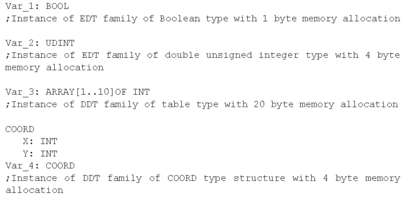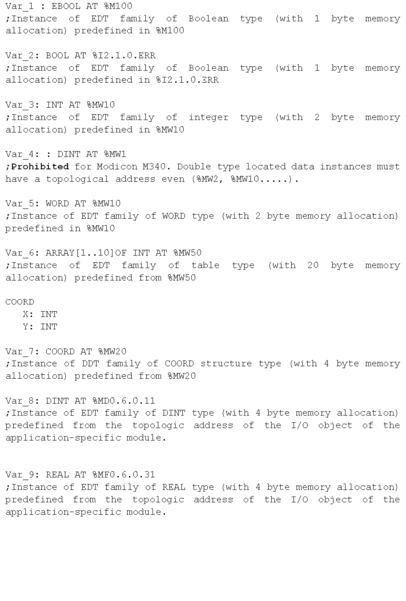Introduction
A data type instance is referenced either by:
a name (symbol), in which case we say the data is unlocated because its memory allocation is not defined but is carried out automatically by the system,
a name (symbol) and a topological address defined by the manufacturer, in which case we say the data is located since its memory allocation is known,
a topological address defined by the manufacturer, in which case we say the data is direct addressing, and its memory allocation is known.
Unlocated Data Instances
Unlocated data instances are managed by the PLC operating system, and their physical location in the memory is unknown to the user.
Unlocated data instances are defined using data types belonging to one of the following families:
Elementary Data Types (EDT)
Derived Data Types (DDT)
Device Derived Data Type (Device DDT)
Function Block data types (EFB\DFB)
Sequential Function Chart data types (SFC)
Examples:

Located Data Instances
Localizing a variable (defined by a symbol) consists in creating an address in the variable editor.
Located data instances have a predefined memory location in the PLC, and this location is known by the user:
Topological address for input/output modules
Global address (M340, Premium) or State RAM (M580, M340, Quantum)
Located data instances are defined using data types belonging to one of the following families:
Elementary Data Types (EDT)
Derived Data Types (DDT)
Input/Output Derived Data Types (IODDT)
The list below shows the datas instances that should be located on a %MW, %KW addresses type:
INT,UINT,WORD,BYTE,DATE,DT,STRING,TIME,TOD,DDTstructure type,Table.
EBOOL or EBOOL tables, datas
instances have to be located on a %M , %Q or %I addresses type.
IODDT datas instances
type have to be located by %CH module channel type.
%MW, %KW addresses type. Only I/O objects instances
type localization is possible with %MD<i>, %KD<i>, %QD, %ID, %MF<i>, %KF<i>, %QF, %IF type by using their topological address (for
example %MD0.6.0.11, %MF0.6.0.31).%MW and %KW).Examples:

Direct Addressing Data Instances
Direct addressing data instances have a predefined location in the PLC memory or in an application-specific module, and this location is known to the user.
Direct addressing data instances are defined using types belonging to the Elementary Data Type (EDT) family.
Examples of direct addressing data instances:
Internal |
Constant |
System |
Input/Output |
Network |
|---|---|---|---|---|
%M<i> |
%S<i> |
%Q, %I |
||
%MW<i> |
%KW<i> |
%SW<i> |
%QW, %IW |
%NW |
%MD<i> (1) |
%KD<i> (1) |
%QD, %ID |
||
%MF<i> (1) |
%KF<i> (1) |
%QF, %IF |
||
Legend: |
||||
(1) Not available for Modicon M340 |
||||
Example:
Var_1: DINT AT
%MW10;%MW10 and %MW11 are both used.
%MD10direct addressing can be used or Var_1 in the program.


